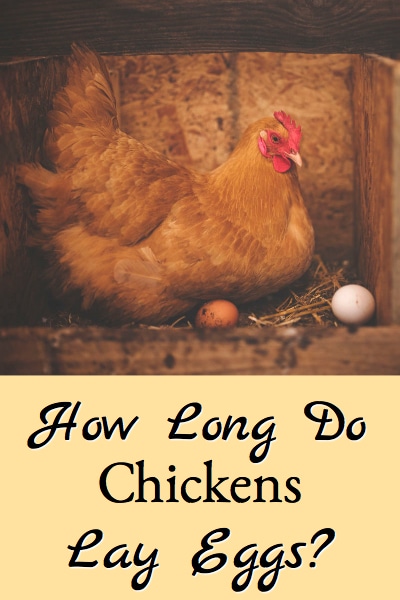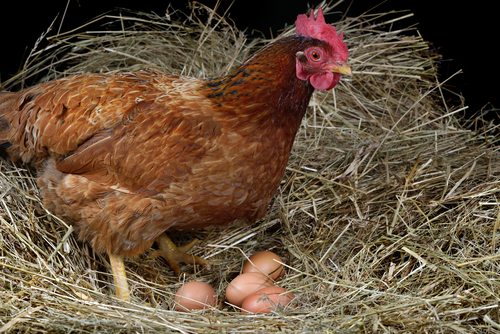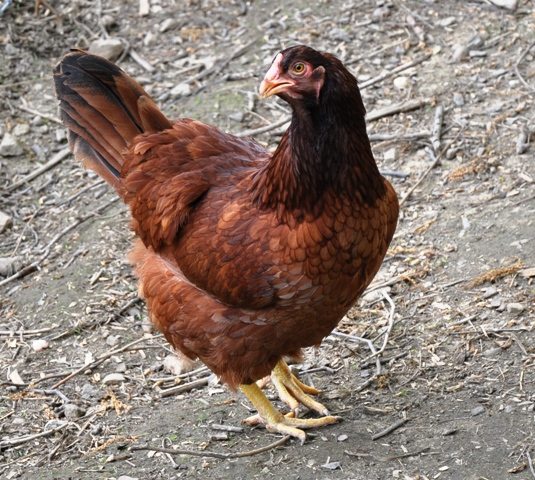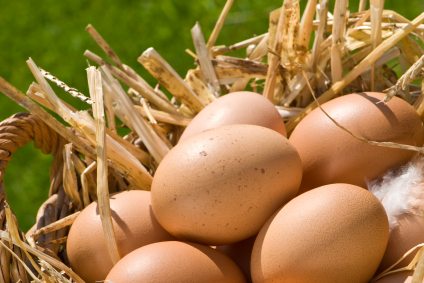How long chickens lay eggs is a question we often get and the answer is – it really depends on the chicken breed.
If the chickens are from one of the hybrid egg-laying breeds, then although they are capable of laying eggs for many years, they’re seldom kept that long.
Heritage or traditional breeds, on the other hand, are often kept much longer and will lay eggs into their old age.
Chickens are born with the capability to produce a set number of eggs over their lifetime, and it’s sometimes reported that keeping coop lights on in the winter to maintain egg production reduces the number of years that a chicken will lay. However, there’s no evidence to support this and chickens will lay eggs until they die of old age without running out of them.
Egg-Laying Hybrid Breeds
These breeds (Golden Buffs, Red Comets, Black Sex Links, etc.) are meant to produce eggs as quickly as possible with minimal feed input. They were bred to maximize production while minimizing costs.
They are the breeds that most commercial egg producing operations use and they usually keep the birds for about two years before replacing them. During those first two years, these breeds will produce nearly an egg a day (so 300+ eggs per year is typical) making them the best producers, but after that, they slow down so significantly that they’re not financially viable for the commercial egg producers. These breeds may also produce through winter (when young) without the addition of added light.
They are very lightweight birds, so commercial operations generally cull them and don’t make any attempt to use them for meat. Since they are commonly replaced so young in commercial situations, some believe that they quit producing eggs after about two years. However, that’s not true and they will continue to produce eggs for a couple more years – just not nearly at their initial rate.

Golden Buff and Eggs
Traditional Laying Breeds
Traditional breeds (like Buckeyes, Barred Rocks, or Rhode Island Reds) typically hit maximum production at around two years and then decrease about 10% a year after that. They won’t ever produce eggs at the initial rate of the egg-laying breeds but can easily produce a fairly consistent number of eggs for the first four to five years.
These were the breeds that were traditionally kept on small farms to provide eggs for the farm and they are well adapted to foraging and changing climatic conditions. They make great backyard chickens but generally won’t lay through the winter months unless a light is added to the coop to maintain at least 14 hours of day length (see Maintain Winter Egg Production – Add Artificial Light).
Many of the traditional breeds are also considered “dual-purpose” birds, meant that they were intended to produce both eggs and meat for the table. Once they were too old to produce reliable numbers of eggs, then they went into the stewing pot because they were large enough to make using them for meat worthwhile.

Buckeye Hen
What’s Best for Backyard Flocks?
What’s best for your backyard flock depends on your goals. If getting lots of eggs so that you can provide for your family and sell eggs to your neighbors and community is important, then clearly the hybrid breeds are a good place to start. Just remember that after around two years, these birds will need to be replaced if you want continued high production.
If having a few chickens to produce eggs and meat for your family is the goal, then the traditional birds are probably a better place to start. Exactly how long they will continue to do that depends on the traditional breed chosen and the individual bird, but they will generally keep producing eggs for many years if allowed to stay.
Many chicken-keepers like to keep a mixed flock of both hybrid birds and heritage birds. That’s what we’ve chosen to do. Each year we incubate a couple of heritage Buckeyes (see About Buckeye Chickens) but also buy a couple hybrid day-old Golden Buffs. We’ll raise the chicks together and add them to the flock while removing some of the oldest Golden Buffs and Buckeyes to use for the stew pot. That way, all our birds get to live a long and productive life foraging in their pasture regardless of exactly how many eggs they are producing.
Like us, many backyard chicken-keepers get attached to their birds and find that as they age, egg production is not their top priority. In these cases, the birds may live a long time and although they may only produce one egg a year, they’ll keep laying!

Freshly Laid Eggs
Kristi Wheeler says
We love our chickens, the eggs are a bonus really! Thanks for all the great info Lesa!
JUSTIN B. says
JUST ORDED 35 GOLD SEX LINKS TODAY 3/11/19 . AND SHOULD HAVE THEM IN ON WEDNESDAY 3/13/19
THIS IS THE FIRST TIME EVER FOOLING WITH GLOD SEX KINKS AND THE COMMENTS I READ ABOVE . IT SEEMS LIKE I MADE A GREAT DECISION WITH GOING WITH THIS KIND OF BREED . THANK YOU
Belladonna Took says
Hi, Lesa … I started out insisting that I wanted heritage breeds. I’ve had Buff Orpingtons, Rhode Island Reds and Leghorns, as well as a few Ameracaunas. I keep them because I just like having chickens, and I LOVE having fresh eggs for us and to give to friends. Recently I’ve decided that I want to pull out all stops, and after a long period of faffing around try to make our farmlet (5 acres in E. Washington) reasonably self-sustaining. Ameracaunas’ blue eggs are fun but they’re not frequent layers. The Buffs and Rhodies lay well and have quite nice temperaments; I NEVER want Leghorns again – fantastic layers, but the most annoyingly skittish birds imaginable.
Anyway, last year I allowed myself to be persuaded to try Golden Sexlinks … and I have fallen in love. Typically when I introduce new youngsters into a flock the other hens would attack them – I put them in adjoining pens so they have time to get acquainted, but if I didn’t they’d be beaten up. When I introduced a second batch of Sexlinks, a couple of the first batch managed to get over the fence to the chicks, and to my amazement they appointed themselves as nannies. They talked to the chicks, showed them around the pen, scratched for them – they were just lovely! They’re also incredibly relaxed around humans … They don’t exactly *like* being picked up, but but when I pick one up for a cuddle she’ll settle down quickly and actually seems to enjoy it.
I would love to have a mixed flock of Sexlinks and a heritage breed, but having learned that not all chickens behave like maddened pterodactyls I’d like to find a gentle breed. Can you recommend one?
Lesa says
Hi Belladonna, We also love the Golden Sexlinks – they make up most of our flock. I’m glad you found them. We like the Buckeyes as a heritage breed, they seem to be very friendly birds, are good at foraging, and take our Ohio winters well.
stephanie says
Do Easter Eggers count as a heritage breed or more like a hybrid?
Lesa says
Hi Stephanie, we haven’t had Easter Eggers, but I believe they’ve been around for a long time and are therefore a traditional breed, not a hybrid. Our neighbors have Easter Eggers and have commented that they like them better than the Golden Buffs (hybrids) because they keep laying at a reasonable rate for longer.